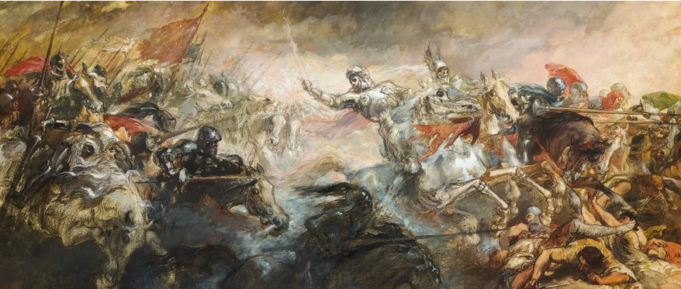War, as an inherent aspect of human history, has not only reshaped geopolitical boundaries but also profoundly influenced cultural landscapes and artistic expressions. Tracing its origins to prehistoric tribal skirmishes, warfare evolved with the rise of organized states in Mesopotamia, where the Standard of Ur, possibly the world’s first war memorial, vividly depicted the collective and personal glories and horrors of battle. Throughout the centuries, as empires expanded and contracted, war spurred the creation of some of the most impactful art, reflecting the time’s prevailing attitudes and technologies. Ancient Greek pottery, for instance, celebrated the heroic ideal of the warrior, while Roman triumphal arches commemorated military victories and the supposed virtues of order over chaos.
In the Middle Ages, narrative tapestries such as the Bayeux Tapestry used intricate visuals to document battles, such as the Norman Conquest of England, serving both as historical records and propaganda tools. The Renaissance brought a more personal perspective to war art, with artists like Leonardo da Vinci and Albrecht Dürer infusing their works with both technical precision in depicting war machines and a deeper contemplation of human suffering. This era set the stage for the dramatic, often brutal works of the Baroque period, where artists such as Peter Paul Rubens captured the visceral emotion of conflict, reflecting the tumultuous struggles of the Thirty Years’ War.
The advent of photography in the 19th century revolutionized war art by capturing real-time images of the Civil War in America, offering unembellished snapshots of the battlefield that brought the grim realities of war to the public’s doorstep. These photographic stories made the horrors of war palpable, fostering a new form of visual journalism that questioned the glory traditionally associated with military conflict. World War I further shifted the perspective with artists like Otto Dix, who, through his raw depictions of the Western Front, underscored the grotesque mutilations both physical and psychological, borne by the soldiers, thereby profoundly questioning the very nature of war itself.
World War II inspired myriad artistic responses highlighting both heroic resistance and profound tragedy. Picasso’s “Guernica” became an emblematic cry against the atrocities of war, using disfigured forms and a monochromatic palette to scream the pain of innocent civilians. Post-war art movements such as Abstract Expressionism and Pop Art in the United States indirectly reflected the Cold War tensions, using abstract forms to explore complex emotional and intellectual reactions to the threat of nuclear war.
In contemporary times, digital media and installations continue to evolve as platforms for expressing and reflecting on war’s impacts. Artists like Banksy utilize street art to deliver powerful anti-war messages that are accessible to a broad audience, demonstrating how public spaces can serve as canvases for protest. Meanwhile, virtual reality experiences now immerse viewers in the battlefield, providing firsthand glimpses of the chaos and fear soldiers face, thereby fostering a deeper empathy and understanding.
As we delve deeper into the annals of war’s impact on culture, it becomes imperative to explore some of the most seminal conflicts that have left indelible marks on society and art. The Peloponnesian War, fought between Athens and Sparta in the 5th century BC, not only reshaped Ancient Greek politics but also influenced dramatic tragedies that pondered themes of power, hubris, and fate. These themes are vividly portrayed in the works of Sophocles and Thucydides, whose histories and plays examine the moral and ethical decay precipitated by prolonged conflict. Moving forward in time, the Hundred Years’ War between England and France served as a backdrop for transformative changes in military tactics and heralded the decline of chivalry depicted in the chansons de geste and artworks like the miniatures in the Chronicles of Froissart, which illustrate the valor and violence of knights.
Another epoch-defining series of conflicts was the Napoleonic Wars, which not only altered the map of Europe but also had a profound influence on the Romantic artists of the time. Painters like Goya and Turner portrayed the sweeping and tumultuous battles in stark, emotional terms, capturing the tumult of Europe under Napoleon’s rule. Goya’s “Disasters of War” series brutally highlights the suffering of civilians and the horrors of the Peninsular War, while Turner’s “The Field of Waterloo” immerses viewers in the chaotic aftermath of the battle, reflecting on the cost of victory. These artworks not only chronicle military events but also serve as critical commentaries on the impact of warfare on the human spirit, challenging the glorified narratives often propagated by the victors.
War’s legacy in culture thus serves as a powerful mirror and a beacon. It not only reflects societal values and experiences but also prompts a re-evaluation of the narratives we accept about valor, sacrifice, and the costs of conflict. The persistent resonance of war in art underscores its profound impact on human consciousness and cultural identity, challenging each generation to interpret its echoes through the lens of current realities and future aspirations. Anchoring this broad spectrum are pivotal warfare artworks that not only document the physical landscapes of war but also map the emotional and moral topographies of their times, guiding public sentiment and intellectual discourse about one of humanity’s most enduring and devastating phenomena.


















